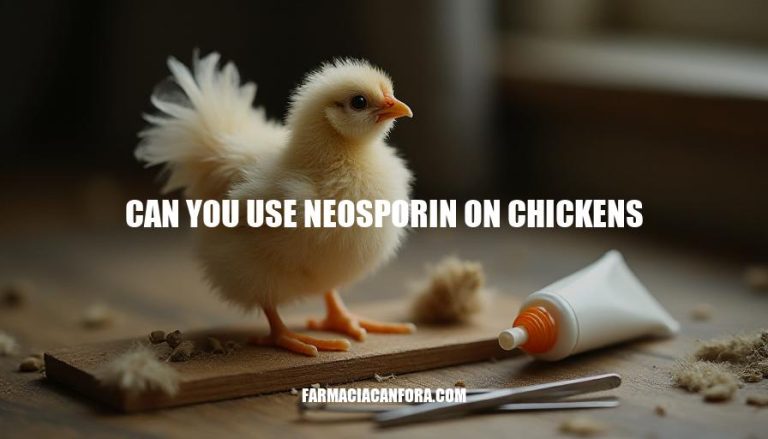


When it comes to taking care of chickens, keeping them healthy is super important. Sometimes they get hurt and we need to help them heal. That’s where Neosporin comes in – it’s an antibiotic ointment that can prevent infections and help cuts and scrapes heal faster.
It’s easy to find at most stores and works really well. So if your chicken gets hurt, using Neosporin might be a good idea.
To properly apply Neosporin to chickens, follow these detailed instructions:
Safety Precautions:
Ensure the Neosporin does not contain any “caine” type pain relievers (e.g., Lidocaine) as these are toxic to birds.
Wear disposable gloves to prevent contamination and protect yourself from potential infections.
Keep the treated chicken isolated from other birds to prevent pecking at the wound and ingestion of the ointment.
Recommended Dosage:
Use a small amount of Neosporin, just enough to cover the affected area. Over-application is unnecessary and can be wasteful.
Steps to Follow:
Clean the Wound: Gently clean the wound with warm water and mild soap. Avoid using harsh chemicals or hydrogen peroxide as they can damage the tissue.
Dry the Area: Pat the area dry with a clean cloth or paper towel.
Ensure the wound is completely dry before applying the ointment.
Apply Neosporin: Using a clean cotton swab or your gloved finger, apply a thin layer of Neosporin to the wound. Make sure to cover the entire affected area.
Cover the Wound: If possible, cover the wound with a sterile bandage or gauze to protect it from dirt and pecking. This may not always be feasible, especially if the wound is in a difficult-to-cover area.
Monitor the Chicken: Keep an eye on the chicken for any signs of infection or adverse reactions.
If the wound does not improve or worsens, consult a veterinarian.
Additional Tips:
Can You Use Neosporin on Chickens: Yes, you can use Neosporin on chickens as long as it does not contain any “caine” type pain relievers.
Frequency of Application: Apply Neosporin 1-2 times daily until the wound has healed.
Hygiene: Always wash your hands thoroughly after handling the chicken and treating the wound.
By following these steps, you can safely and effectively use Neosporin to treat wounds on your chickens.
Using Neosporin on chickens can be beneficial in treating wounds and preventing infections, but it’s essential to follow proper safety precautions and dosage guidelines. The antibiotic ointment works well in promoting faster healing of cuts and scrapes, making it a good option for chicken owners.
However, there are potential risks associated with using Neosporin on chickens, such as the presence of “caine” type pain relievers that can be toxic to birds. To avoid this, ensure that the Neosporin you use does not contain these ingredients.
To safely apply Neosporin on chickens, follow these steps: clean and dry the wound, apply a thin layer of ointment using a clean cotton swab or gloved finger, cover the wound with a sterile bandage if possible, and monitor the chicken for signs of infection or adverse reactions. It’s also essential to wear disposable gloves, keep the treated chicken isolated from other birds, and wash your hands thoroughly after handling the chicken.
Neosporin can be used on chickens as long as it meets the safety criteria, and it should be applied 1-2 times daily until the wound has healed. By following these guidelines, you can effectively use Neosporin to treat wounds on your chickens.
Can you use Neosporin on chickens? Yes, but with caution and proper application.